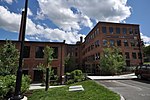Mill Village Historic District (Williamstown, Massachusetts)
Historic districts in Berkshire County, MassachusettsHistoric districts on the National Register of Historic Places in MassachusettsNRHP infobox with nocatNational Register of Historic Places in Berkshire County, MassachusettsUse mdy dates from August 2023 ... and 1 more
Williamstown, Massachusetts

The Mill Village Historic District is a historic district encompassing a well-preserved 19th century mill village in Williamstown, Massachusetts. It is located on Cole Avenue and other streets east of Cole and south of the Hoosac River, which provided the mill's power. The complex dates to the mid-19th century, and includes tenement houses, housing for supervisors and specialty personnel, as well as a surviving mill building. The village district was listed on the National Register of Historic Places in 1983.
Excerpt from the Wikipedia article Mill Village Historic District (Williamstown, Massachusetts) (License: CC BY-SA 3.0, Authors, Images).Mill Village Historic District (Williamstown, Massachusetts)
Arnold Street,
Geographical coordinates (GPS) Address Nearby Places Show on map
Geographical coordinates (GPS)
| Latitude | Longitude |
|---|---|
| N 42.716666666667 ° | E -73.190277777778 ° |
Address
Arnold Street 39;41
01267
Massachusetts, United States
Open on Google Maps








